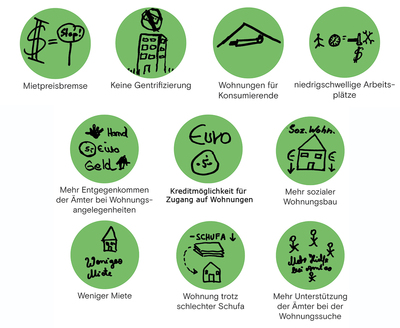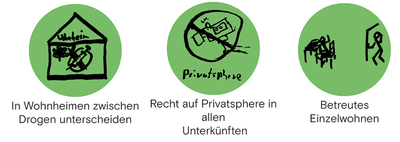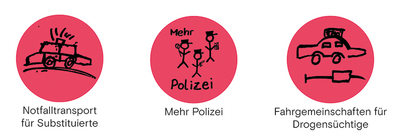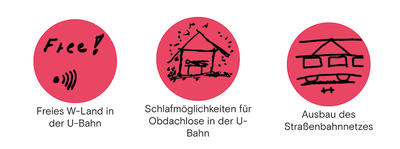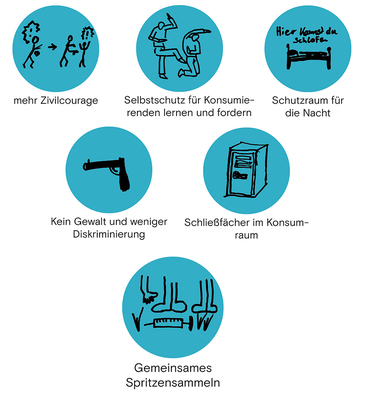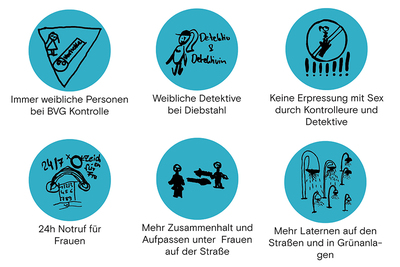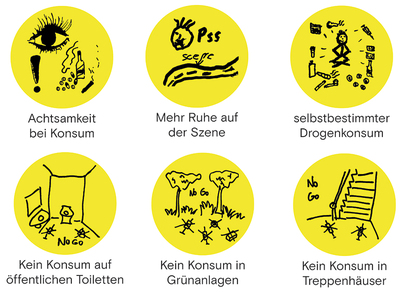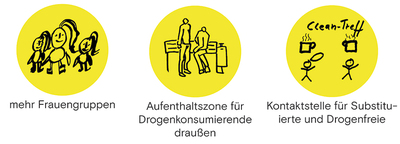Travel through an Ideal City of Marginalised Drugs Users
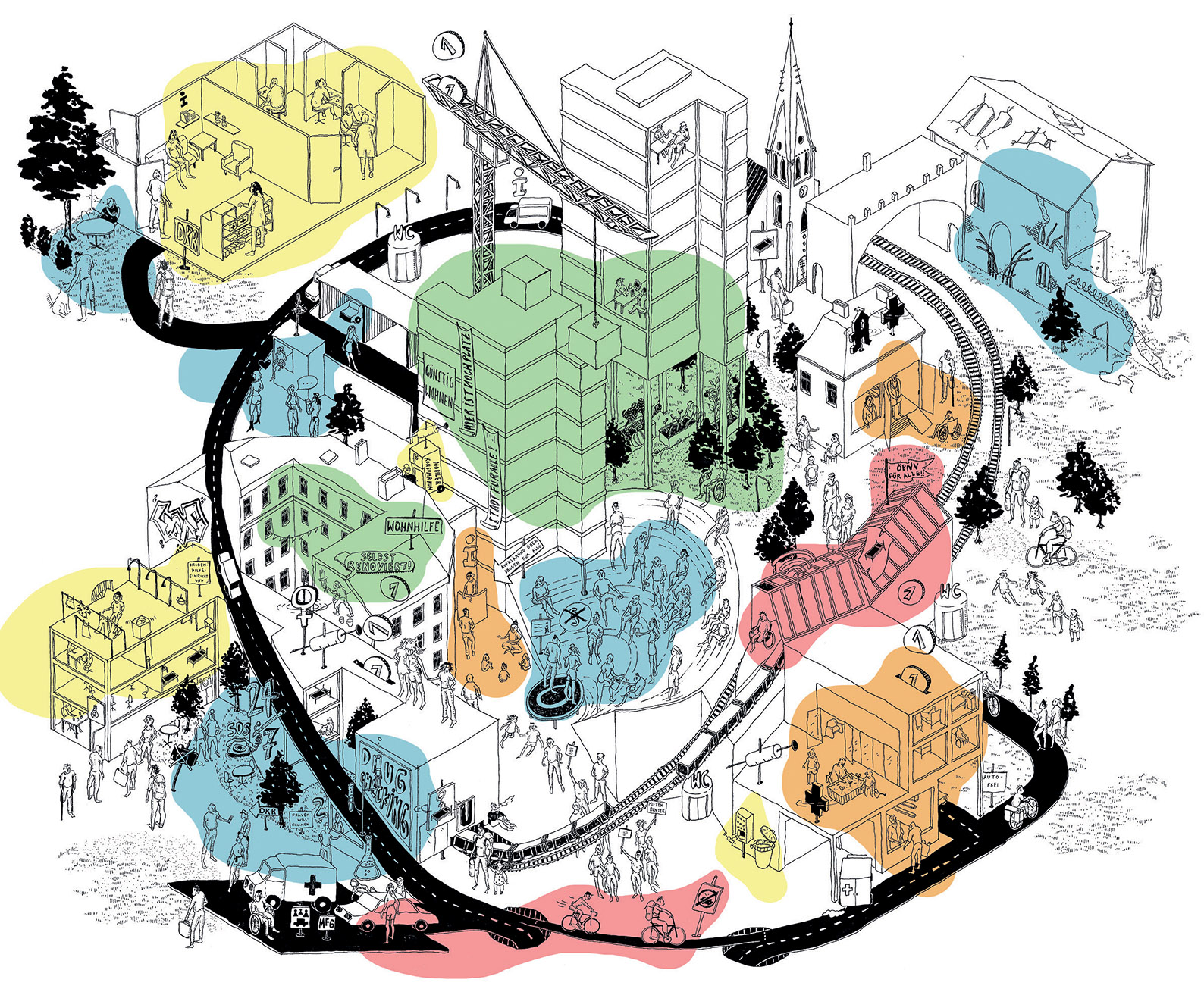
Image: Studio 8/4, 2019
Text: Melina Germes, 10/2021
Look at this picture. It’s a huge drawing of how an ideal city could look – but not just any ideal city: the city of drug users, imagined from a variety of marginalized positions. We, a lot of people in Berlin and Frankfurt, worked hard together for months back in 2019 to come up with this drawing. Now it's here and it's telling us so much. Let's travel forward in time.
At the top left, there is a ruin with a blue stain: it’s a former prison. It is obsolete because now drugs are legal. The decades during which they were illegal in Germany led to a number of catastrophes, among them the emergence of a uncontrollable black market, the exploitation of workers, the economic and social precarity of many drug users (not upper class), and disastrous health consequences ranging from the spread of HIV to systemic discrimination in healthcare. That was in the past. Today, there is no need for any prison. Back then, German prisons were full of people who used drugs who were convicted for drug possession, drug trade, petty crime, or even just not having paid for public transportation. Many of these people who spent weeks or months in jail mainly because of drugs lost everything: the home they had struggled to get, the social and affective relationships they had built… Once out, they would have to begin a new life from scratch. Today, nobody loses their life to drug prohibition anymore.
And you know what? The city is saving lots of money. Police, criminal justice, and prison systems are expensive – and now, all this funding goes to the most important places in the city.
Housing
Because, you know, having no home is the worst thing of all in this part of the world. Particularly when you use substances or when you have a medical condition. Then you need rest, intimacy, a place of your own to take care of yourself – that’s a fundamental right that is enforced. This is such a basic fact: as a drug consumer, you can’t feel better before you get safe housing that suits your needs. That’s why such a lot of money is invested in housing here. You see the green parts of the drawing? This is where new homes are being built, taking over old buildings and renovating them and moving people in. Also, for those who need support in everyday life, there also assisted housing facilities. A lot of the new housing is for women, trans* and inter people only, because they often have had very bad experiences with cis men, so they feel better without them.
Transportation
You see the pink stain on the train station? Now, local and regional stations are truly welcoming places: no need to worry about buying a ticket or paying a huge fine, you just go in and out as you like, without fear, and you can travel by bus or tram everywhere in the city. You can move easily back and forth between your home (because you have a home!) and the doctor’s office or the drug consumption room, without having to worry about it. If you are going through a very difficult time, you know there is always an accessible, decent shelter in the station – in the worst case, that’s your emergency net. You see the other pink stain? That’s where public transportation can’t help you, because you are too far away, or because you are in acute withdrawal and can’t really move. Then you can just call, and a community carpool picks you up and takes you to the next hospital, doctor, pharmacy, or wherever you want to go. Yeah, and you can see how the streets are great, with places for everyone, bikes and car alike…
Healthcare
These are the orange marks on the picture. Now, everyone – I mean, literally everyone without any exception – can go to the doctor, to the pharmacy, to the hospital, can call for emergency support and be welcomed, listened to carefully and cared for well. You know, now we don’t have to show any insurance paper or card or whatever, like we used to do in the past. Like the bureaucracy used to make us do. We just show up ourselves. Instead of paying bureaucrats to decide which life is worth what, we pay doctors to take care of people! We show up and there are enough health care personal, enough material, and all the necessary machines. Medication is also completely free. Something else that is very important: you just show up and you are seen. The staff is highly trained in non-discriminatory behaviors. Whatever you use for substances; whoever you are; wherever you come from; everyone is very careful to point out racist, sexist, ableist, classist behaviors. Because there is no access to medicine when health care practice remains discriminatory.
Harm reduction
These are the yellow stains on the picture. It doesn’t matter how much social justice a city has, harm reduction is always needed. This is no longer the small-scale, petty, scarce harm reduction you used to know. Now it’s in every street, in each neighborhood, at the outskirts of the city. Lots of these places are for women only. Others are for LGBTIQ people only. In the whole society, there is less control and more knowledge, there is acceptance and non-discrimination toward substance users. Help is in reach for everyone, citizen and foreigners, available in a multitude of languages.
Safety
The other blue stains stand for safety. The safety of drug users in the whole urban space is a priority: no need to hide anymore; there are even specific meeting places for the community, inside and outside. Sexwork is safe, involving reflection on non-discrimination, support hotlines, a radical transformation of the police, etc.
We all deserved this city – and now it’s real, it’s here, and not only we, drug users, are thriving, but also everyone else. Our ideal city is your ideal city.
With this text, I tried to put into words the utopian reach of such a research process centering drug users. It raises the question of the position of (marginalized) drug users:
First, their position in the city planning. The future this picture is showing you is one where the whole city-wide and regional planning seriously takes into account marginalized perspectives – here, the perspectives of marginalized drug users – in order to make a city that is better for everyone. It’s crucial to envision issues relating to drug use and harm reduction at an urban scale, as a broader urban policy topic – not squeezing these issues between health and social work. We have to dream big.
Second, the project behind the picture highlights the fact that marginalized drug users are neither a homogenous nor revolutionary subjects as such. What this picture doesn’t show is that we don’t all dream the same. There were a lot of diverse subjects involved in making the picture. We organised three workshop, among which one of them was only for womenn trans and inter people. There were broader differences – between the persons with German nationality and thus more benefits than the one just arriving from Poland. There was some xenophobia. There were not a lot of more marginalized participants – we couldn’t reach them. Centering marginalized drug users is of the utmost importance – under the condition that we understand the different kinds of marginalization and power relationships among marginalized groups – as well as our power relationships, as researchers and research participants.
Let’s dig deeper and search more in order not only to give them “a” voice, but to give them “voices.”
Proof-reading: Sage Anderson
The production of the picture above is the result of a very collective process involving the DRUSEC french-german research team, Fixpunkt researchers and social workers, many dozens of workshop participants as well as the berlin Studio 8/4 in charge of the exhibition design. This process is described and reflected upon in the following paper:
Mélina Germes and Luise Klaus, "When marginalized subjects map their city: Counter-mapping experiments with drug users in some German and French neighborhoods", Bulletin of Methodological Sociology, Volume: 152 issue: 1, pages: 96-124, https://doi-org/10.1177/07591063211040234 .
You can have a look at the whole results of the workshops in the following collection, or browse by topic below:
The ideal cities of marginalized drug users
Housing
Transportation
Safety
Health
-

Urban quality of life for everyone
-
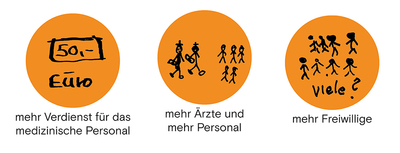
Solidarity with the hospital strikes
-

Waiting less and having more time
